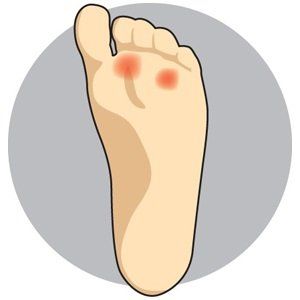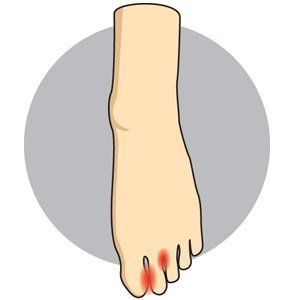Calluses, Blisters & Corns
What Are Calluses, Blisters and Corns?
Calluses, blisters and corns are uncomfortable skin conditions.
All three conditions result due to repeated friction between the skin and another surface. These conditions are easy to prevent and treat.
- Calluses are areas of dry thickened skin, found on hands and heels. These develop over long periods of repetitive pressure and friction.
- Blisters are a liquid containing bubbles that form on the skin, at the point of friction and pressure. These appear first after friction and lead to calluses if untreated. The liquid can be clear, and in some cases contain pus or blood.
- Corns are also areas of dry thickened skin resulting from peak pressure over a small surface area. The thickened skin develops a nucleus of hard skin (corn) that can become painful.
Who Does Calluses, Blisters and Corns Affect?
Calluses, blisters and corns can affect anyone, regardless of gender and age.
People whose feet are exposed to prolonged pressure
- Athletes,
- People performing repetitive movements, and
- Those wearing poorly fitting shoes
How Does Calluses, Blisters and Corns Occur?
Calluses begin with the development of dry thickened skin, due to repeated pressure caused by friction. Poorly fitting shoes are one of the main causative factors of callus as is poor foot biomechanics.
Blisters occur at the same sites at the calluses and happen before callus formation. They are formed due to shorter exposure to friction and rubbing and appear faster than calluses.
Blisters on the foot can form due to wearing improper shoes or not using proper gloves when using tools and performing other repetitive tasks.
Corns are also areas of thickened skin on top or in between the toes that also develops in response to repeated pressure and friction.
How are Calluses, Blisters and Corns Treated?
The treatment for these skin conditions ranges from
- Prevention,
- Self-treatment, and
- Doctor prescribed medication.
Prevention of Callus, Blisters or Corns can include:
- Proper hydration of skin by using skin moisturizer and drinking a lot of liquids,
- Wearing proper shoes and insoles that don’t pinch the feet or cause pain.
Treatment of existing Callus, Blisters or Corns can include the following:
- Calluses : Wearing proper shoes and pads, keeping heels moisturized using skin care lotions and using a gel or liquid bandage prevents further damage and allows for quicker healing period. Using a pumice stone after bathing can remove the dead skin and help in the healing process.
- Blisters : These often heal by themselves, but keeping the area clean and dry by using a bandage is a good idea. It is recommended not to puncture them yourself or put pressure on them.
- Corns : These take the longest to heal. Using proper pads and comfortable fitting shoes can help. Using a pumice stone after bathing can remove the dead skin and help in the healing process.
If these conditions still exist even with self-treatment, a doctor may perform
- Debridement - the medical removal of dead, damaged, or infected tissue to improve the healing potential of the remaining healthy tissue
- Heel strapping, and
- Prescription medicine containing higher strengths of urea and salicylic acid.
What if Calluses, Blisters and Corns are Untreated?
- Infection (cellulitis), and
- Diabetic foot ulcers which are of serious concern.







